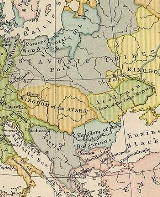
Political entities inhabited or ruled by Serbs
Encyclopedia
This is a list of Serb countries and regions throughout history
, called Serbian lands by historians . It includes empire
s, countries
, states
, provinces, regions and territories that have or had in the past one of the following characteristics:
It also includes states of Prehistoric Serbia
(States within or part of present Serbian territory).
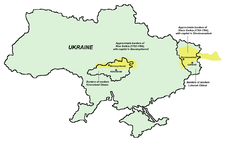
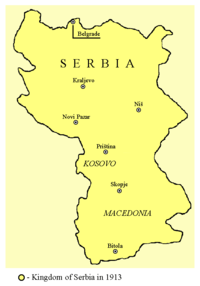
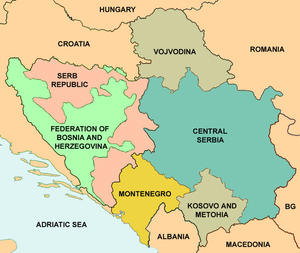 This is the list of the current states and regions where Serbs are in absolute or relative ethnic majority, are one of the constitutional or recognized peoples or Serbian language is official:
This is the list of the current states and regions where Serbs are in absolute or relative ethnic majority, are one of the constitutional or recognized peoples or Serbian language is official:
History
History is the discovery, collection, organization, and presentation of information about past events. History can also mean the period of time after writing was invented. Scholars who write about history are called historians...
, called Serbian lands by historians . It includes empire
Empire
The term empire derives from the Latin imperium . Politically, an empire is a geographically extensive group of states and peoples united and ruled either by a monarch or an oligarchy....
s, countries
Country
A country is a region legally identified as a distinct entity in political geography. A country may be an independent sovereign state or one that is occupied by another state, as a non-sovereign or formerly sovereign political division, or a geographic region associated with a previously...
, states
Sovereign state
A sovereign state, or simply, state, is a state with a defined territory on which it exercises internal and external sovereignty, a permanent population, a government, and the capacity to enter into relations with other sovereign states. It is also normally understood to be a state which is neither...
, provinces, regions and territories that have or had in the past one of the following characteristics:
- An ethnic SerbSerbsThe Serbs are a South Slavic ethnic group of the Balkans and southern Central Europe. Serbs are located mainly in Serbia, Montenegro and Bosnia and Herzegovina, and form a sizable minority in Croatia, the Republic of Macedonia and Slovenia. Likewise, Serbs are an officially recognized minority in...
majority - Serbs are an official, constitutional or titular nation
- SerbianSerbian languageSerbian is a form of Serbo-Croatian, a South Slavic language, spoken by Serbs in Serbia, Bosnia and Herzegovina, Montenegro, Croatia and neighbouring countries....
as an official languageOfficial languageAn official language is a language that is given a special legal status in a particular country, state, or other jurisdiction. Typically a nation's official language will be the one used in that nation's courts, parliament and administration. However, official status can also be used to give a... - A Serb ruling class or dynasty
It also includes states of Prehistoric Serbia
Prehistoric Serbia
The best known cultural archaeological discoveries from the prehistoric period on the territory of modern-day Serbia are the Starčevo and Vinča cultures dating back to 6400-6200BC....
(States within or part of present Serbian territory).
Early
| Map | Name | Years | Area Area Area is a quantity that expresses the extent of a two-dimensional surface or shape in the plane. Area can be understood as the amount of material with a given thickness that would be necessary to fashion a model of the shape, or the amount of paint necessary to cover the surface with a single coat... |
Notes |
|---|---|---|---|---|
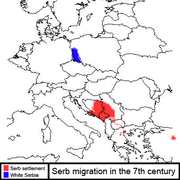 |
White Serbia White Serbia White Serbia or Bojka , is the mythical homeland of the ancestors of the Serbs, of the White Serbs .The area adjacent to White Serbia was known as White Croatia, where the Croats trace their origin... or Bojka |
? | The location of White Serbia has been disputed. It has been described as:
|
Traditional homeland of the White Serbs in Europe Europe Europe is, by convention, one of the world's seven continents. Comprising the westernmost peninsula of Eurasia, Europe is generally 'divided' from Asia to its east by the watershed divides of the Ural and Caucasus Mountains, the Ural River, the Caspian and Black Seas, and the waterways connecting... . |
| Serbian Sklavinia Serbian Sklavinia The Slavs ravaged the Balkans beginning in the 520s, their occupied territories were called Sklavinia and where de facto independent, but were still claimed by the Byzantines. The Serbian Sklavinia refers to the territories of Serbs before the mentioning of a state in primary sources in fl... |
fl. 610-641 (680) | Balkans Balkans The Balkans is a geopolitical and cultural region of southeastern Europe... |
||
Monarchy
| Image | Map | Name | Years | Area Area Area is a quantity that expresses the extent of a two-dimensional surface or shape in the plane. Area can be understood as the amount of material with a given thickness that would be necessary to fashion a model of the shape, or the amount of paint necessary to cover the surface with a single coat... |
Notes |
|---|---|---|---|---|---|
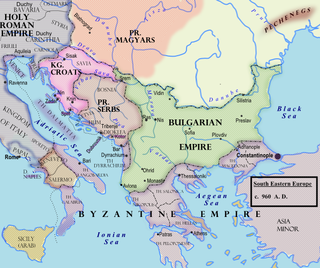 |
Serbian Principality | ~768-969 | Serbia Serbia Serbia , officially the Republic of Serbia , is a landlocked country located at the crossroads of Central and Southeast Europe, covering the southern part of the Carpathian basin and the central part of the Balkans... BiH BIH BIH is a three letter initialism that can stand for:*Benign intracranial hypertension*Bihari language, ISO 639 alpha-3 language code*Bilateral inguinal hernia Bosnia and Herzegovina, ISO 3166-1 alpha-3 country code... Montenegro Montenegro Montenegro Montenegrin: Crna Gora Црна Гора , meaning "Black Mountain") is a country located in Southeastern Europe. It has a coast on the Adriatic Sea to the south-west and is bordered by Croatia to the west, Bosnia and Herzegovina to the northwest, Serbia to the northeast and Albania to the... Croatia Croatia Croatia , officially the Republic of Croatia , is a unitary democratic parliamentary republic in Europe at the crossroads of the Mitteleuropa, the Balkans, and the Mediterranean. Its capital and largest city is Zagreb. The country is divided into 20 counties and the city of Zagreb. Croatia covers ... Albania Albania Albania , officially known as the Republic of Albania , is a country in Southeastern Europe, in the Balkans region. It is bordered by Montenegro to the northwest, Kosovo to the northeast, the Republic of Macedonia to the east and Greece to the south and southeast. It has a coast on the Adriatic Sea... |
Held by the Vlastimirović dynasty. Časlav (r. 927-960) liberated the Serbian principalities from Bulgarian rule in 927. He enlarged Serbia, uniting the tribes of Bosnia, Herzegovina Herzegovina Herzegovina is the southern region of Bosnia and Herzegovina. While there is no official border distinguishing it from the Bosnian region, it is generally accepted that the borders of the region are Croatia to the west, Montenegro to the south, the canton boundaries of the Herzegovina-Neretva... , Old Serbia Old Serbia Old Serbia is a modern name for the territory which was the core of medieval Serbia. It included Raška , Kosovo and Metohija and the Macedonia... and Montenegro Montenegro Montenegro Montenegrin: Crna Gora Црна Гора , meaning "Black Mountain") is a country located in Southeastern Europe. It has a coast on the Adriatic Sea to the south-west and is bordered by Croatia to the west, Bosnia and Herzegovina to the northwest, Serbia to the northeast and Albania to the... (incorporated Zeta, Pagania, Zahumlje Zahumlje Zachlumia or Zahumlje was a medieval principality located in modern-day regions of Herzegovina and southern Dalmatia... , Travunia Travunia Travunia was a medieval region, administrative unit and principality, which was part of Medieval Serbia , and in its last years, the Bosnian Kingdom . The county became hereditary in a number of noble houses, often kin to the ruling dynasty. The region came under Ottoman rule in 1482... , Konavle Konavle Konavle is a small region and municipality located southeast of Dubrovnik, Croatia.It is administratively part of the Dubrovnik-Neretva County and forms a municipality with its center at Gruda with a total population of 8,250 people split in 32 villages, in which 96.5% are Croats... , Bosnia Bosnia (region) Bosnia is a eponomous region of Bosnia and Herzegovina. It lies mainly in the Dinaric Alps, ranging to the southern borders of the Pannonian plain, with the rivers Sava and Drina marking its northern and eastern borders. The other eponomous region, the southern, other half of the country is... and Rascia Rascia Rascia was a medieval region that served as the principal province of the Serbian realm. It was an administrative division under the direct rule of the monarch and sometimes as an appanage. The term has been used to refer to various Serbian states throughout the Middle Ages... into Serbia Serbia Serbia , officially the Republic of Serbia , is a landlocked country located at the crossroads of Central and Southeast Europe, covering the southern part of the Carpathian basin and the central part of the Balkans... , "ι Σερβλια"). He took over regions previously held by Michael of Zahumlje, who disappears from sources in 925. De Administrando Imperio De Administrando Imperio De Administrando Imperio is the Latin title of a Greek work written by the 10th-century Eastern Roman Emperor Constantine VII. The Greek title of the work is... describes his realm: the shores of the Adriatic Sea Adriatic Sea The Adriatic Sea is a body of water separating the Italian Peninsula from the Balkan peninsula, and the system of the Apennine Mountains from that of the Dinaric Alps and adjacent ranges... , the Sava river Sava River The Sava is a river in Southeast Europe, a right side tributary of the Danube river at Belgrade. Counting from Zelenci, the source of Sava Dolinka, it is long and drains of surface area. It flows through Slovenia, Croatia, along the northern border of Bosnia and Herzegovina, and through Serbia.... and the Morava valley as well as today's northern Albania Albania Albania , officially known as the Republic of Albania , is a country in Southeastern Europe, in the Balkans region. It is bordered by Montenegro to the northwest, Kosovo to the northeast, the Republic of Macedonia to the east and Greece to the south and southeast. It has a coast on the Adriatic Sea... . |
|
| Serbian Principality [Duklja Duklja Doclea or Duklja was a medieval state with hereditary lands roughly encompassing the territories of present-day southeastern Montenegro, from Kotor on the west to the river Bojana on the east and to the sources of Zeta and Morača rivers on the north.... ] |
1000-1148 | Serbia Serbia Serbia , officially the Republic of Serbia , is a landlocked country located at the crossroads of Central and Southeast Europe, covering the southern part of the Carpathian basin and the central part of the Balkans... BiH BIH BIH is a three letter initialism that can stand for:*Benign intracranial hypertension*Bihari language, ISO 639 alpha-3 language code*Bilateral inguinal hernia Bosnia and Herzegovina, ISO 3166-1 alpha-3 country code... Montenegro Montenegro Montenegro Montenegrin: Crna Gora Црна Гора , meaning "Black Mountain") is a country located in Southeastern Europe. It has a coast on the Adriatic Sea to the south-west and is bordered by Croatia to the west, Bosnia and Herzegovina to the northwest, Serbia to the northeast and Albania to the... Croatia Croatia Croatia , officially the Republic of Croatia , is a unitary democratic parliamentary republic in Europe at the crossroads of the Mitteleuropa, the Balkans, and the Mediterranean. Its capital and largest city is Zagreb. The country is divided into 20 counties and the city of Zagreb. Croatia covers ... Albania Albania Albania , officially known as the Republic of Albania , is a country in Southeastern Europe, in the Balkans region. It is bordered by Montenegro to the northwest, Kosovo to the northeast, the Republic of Macedonia to the east and Greece to the south and southeast. It has a coast on the Adriatic Sea... |
|||
 |
Serbian Grand Principality Serbian Grand Principality The Serbian Grand Principality or Rascia was a medieval state that was founded in 1090, and ended with the elevation to Kingdom in 1217. During the reign of Constantine Bodin, the King of Duklja, Vukan was appointed to rule Rascia as a vassal, and when Bodin was captured by the Byzantines, Vukan... [Rascia] |
1091-1217 | Serbia Serbia Serbia , officially the Republic of Serbia , is a landlocked country located at the crossroads of Central and Southeast Europe, covering the southern part of the Carpathian basin and the central part of the Balkans... BiH BIH BIH is a three letter initialism that can stand for:*Benign intracranial hypertension*Bihari language, ISO 639 alpha-3 language code*Bilateral inguinal hernia Bosnia and Herzegovina, ISO 3166-1 alpha-3 country code... Montenegro Montenegro Montenegro Montenegrin: Crna Gora Црна Гора , meaning "Black Mountain") is a country located in Southeastern Europe. It has a coast on the Adriatic Sea to the south-west and is bordered by Croatia to the west, Bosnia and Herzegovina to the northwest, Serbia to the northeast and Albania to the... Croatia Croatia Croatia , officially the Republic of Croatia , is a unitary democratic parliamentary republic in Europe at the crossroads of the Mitteleuropa, the Balkans, and the Mediterranean. Its capital and largest city is Zagreb. The country is divided into 20 counties and the city of Zagreb. Croatia covers ... Albania Albania Albania , officially known as the Republic of Albania , is a country in Southeastern Europe, in the Balkans region. It is bordered by Montenegro to the northwest, Kosovo to the northeast, the Republic of Macedonia to the east and Greece to the south and southeast. It has a coast on the Adriatic Sea... Macedonia Republic of Macedonia Macedonia , officially the Republic of Macedonia , is a country located in the central Balkan peninsula in Southeast Europe. It is one of the successor states of the former Yugoslavia, from which it declared independence in 1991... |
||
 |
Serbian Kingdom | 1217-1345 | Serbia Serbia Serbia , officially the Republic of Serbia , is a landlocked country located at the crossroads of Central and Southeast Europe, covering the southern part of the Carpathian basin and the central part of the Balkans... BiH BIH BIH is a three letter initialism that can stand for:*Benign intracranial hypertension*Bihari language, ISO 639 alpha-3 language code*Bilateral inguinal hernia Bosnia and Herzegovina, ISO 3166-1 alpha-3 country code... Montenegro Montenegro Montenegro Montenegrin: Crna Gora Црна Гора , meaning "Black Mountain") is a country located in Southeastern Europe. It has a coast on the Adriatic Sea to the south-west and is bordered by Croatia to the west, Bosnia and Herzegovina to the northwest, Serbia to the northeast and Albania to the... Croatia Croatia Croatia , officially the Republic of Croatia , is a unitary democratic parliamentary republic in Europe at the crossroads of the Mitteleuropa, the Balkans, and the Mediterranean. Its capital and largest city is Zagreb. The country is divided into 20 counties and the city of Zagreb. Croatia covers ... Albania Albania Albania , officially known as the Republic of Albania , is a country in Southeastern Europe, in the Balkans region. It is bordered by Montenegro to the northwest, Kosovo to the northeast, the Republic of Macedonia to the east and Greece to the south and southeast. It has a coast on the Adriatic Sea... Macedonia Republic of Macedonia Macedonia , officially the Republic of Macedonia , is a country located in the central Balkan peninsula in Southeast Europe. It is one of the successor states of the former Yugoslavia, from which it declared independence in 1991... |
||
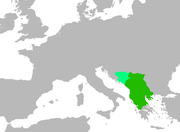 |
Serbian Empire Serbian Empire The Serbian Empire was a short-lived medieval empire in the Balkans that emerged from the Serbian Kingdom. Stephen Uroš IV Dušan was crowned Emperor of Serbs and Greeks on 16 April, 1346, a title signifying a successorship to the Eastern Roman Empire... |
1345-1371 | Serbia Serbia Serbia , officially the Republic of Serbia , is a landlocked country located at the crossroads of Central and Southeast Europe, covering the southern part of the Carpathian basin and the central part of the Balkans... Macedonia Republic of Macedonia Macedonia , officially the Republic of Macedonia , is a country located in the central Balkan peninsula in Southeast Europe. It is one of the successor states of the former Yugoslavia, from which it declared independence in 1991... Montenegro Montenegro Montenegro Montenegrin: Crna Gora Црна Гора , meaning "Black Mountain") is a country located in Southeastern Europe. It has a coast on the Adriatic Sea to the south-west and is bordered by Croatia to the west, Bosnia and Herzegovina to the northwest, Serbia to the northeast and Albania to the... Albania Albania Albania , officially known as the Republic of Albania , is a country in Southeastern Europe, in the Balkans region. It is bordered by Montenegro to the northwest, Kosovo to the northeast, the Republic of Macedonia to the east and Greece to the south and southeast. It has a coast on the Adriatic Sea... Greece Greece Greece , officially the Hellenic Republic , and historically Hellas or the Republic of Greece in English, is a country in southeastern Europe.... Bulgaria Bulgaria Bulgaria , officially the Republic of Bulgaria , is a parliamentary democracy within a unitary constitutional republic in Southeast Europe. The country borders Romania to the north, Serbia and Macedonia to the west, Greece and Turkey to the south, as well as the Black Sea to the east... |
||
| Fall of the Serbian Empire Fall of the Serbian Empire Following the death of child-less Uroš the Weak, the Serbian Empire was left without an heir and the military commanders obtained the rule of the past provinces and districts , continuing their offices with titles such as gospodin and despot etc., given to them during the Empire... |
|||||
| Serbian Despotate Serbian Despotate The Serbian Despotate was a Serbian state, the last to be conquered by the Ottoman Empire. Although the Battle of Kosovo in 1389 is generally considered the end of the medieval Serbian state, the Despotate, a successor of the Serbian Empire and Moravian Serbia survived for 70 more years,... |
In Exile / Short-lived / Titular
- Serbian Empire of Jovan Nenad (1526–1527), Duchy of SyrmiaSyrmiaSyrmia is a fertile region of the Pannonian Plain in Europe, between the Danube and Sava rivers. It is divided between Serbia in the east and Croatia in the west....
of Radoslav ČelnikRadoslav CelnikRadoslav Čelnik was a duke of Srem in the 16th century. At first, Radoslav Čelnik was a general commander of Emperor Jovan Nenad's army. In 1527, when Emperor Jovan Nenad was murdered and his army was dispersed, Radoslav Čelnik, together with part of the former emperor's army moved from Bačka to...
(1527–1530)
Modern political entities


- Military FrontierMilitary FrontierThe Military Frontier was a borderland of Habsburg Austria and later the Austro-Hungarian Monarchy, which acted as the cordon sanitaire against incursions from the Ottoman Empire...
(1579–1881) - Habsburg SerbiaHistory of SerbiaThe history of Serbia, as a country, begins with the Slavic settlements in the Balkans, established in the 6th century in territories governed by the Byzantine Empire. Through centuries, the Serbian realm evolved into a Kingdom , then an Empire , before the Ottomans annexed it in 1540...
(1718–1739) - Kingdom of SlavoniaKingdom of SlavoniaThe Kingdom of Slavonia was a province of the Habsburg Monarchy and the Austrian Empire that existed from 1699 to 1868. The province included northern parts of present-day regions of Slavonia and Syrmia...
(1745–1868) - New SerbiaNova SerbiaNew Serbia was a territory of Imperial Russia from 1752 to 1764. It was mostly located in the territory of present-day Kirovohrad Oblast of Ukraine, although some of its parts were located in the territory of present-day Cherkasy Oblast, Poltava Oblast and Dnipropetrovsk Oblast...
(1752–1764) - Slavo-SerbiaSlavo-SerbiaSlavo-Serbia was a territory of Imperial Russia between 1753 and 1764. It was located by the right bank of the Donets River between the Bakhmut and Lugan rivers...
(1753–1764) - Koča's Frontier (1788–1791)
- Kingdom of Croatia-SlavoniaKingdom of Croatia-SlavoniaThe Kingdom of Croatia-Slavonia or Croatia Slavonia was an autonomous kingdom within the Austro-Hungarian Empire. It was part of the Hungarian Kingdom within the dual Austro-Hungarian state, being within the Lands of the Crown of St. Stephen or Transleithania...
(1868–1918) - Karađorđe's SerbiaHistory of SerbiaThe history of Serbia, as a country, begins with the Slavic settlements in the Balkans, established in the 6th century in territories governed by the Byzantine Empire. Through centuries, the Serbian realm evolved into a Kingdom , then an Empire , before the Ottomans annexed it in 1540...
(1804–1813), Princedom of Serbia (1817–1882), Kingdom of SerbiaKingdom of SerbiaThe Kingdom of Serbia was created when Prince Milan Obrenović, ruler of the Principality of Serbia, was crowned King in 1882. The Principality of Serbia was ruled by the Karađorđevic dynasty from 1817 onwards . The Principality, suzerain to the Porte, had expelled all Ottoman troops by 1867, de...
(1882–1918) - Serbian VoivodeshipSerbian VojvodinaThe Serbian Vojvodina was a Serbian autonomous region within the Austrian Empire...
(1848–1849), Voivodeship of Serbia and Tamiš BanatVoivodship of Serbia and Tamiš BanatThe Voivodeship of Serbia and Banat of Temeschwar or Serbian Voivodeship and Banat of Temeschwar was a province of the Austrian Empire that existed between 1849 and 1860....
(1849–1860) - State of Slovenes, Croats and SerbsState of Slovenes, Croats and SerbsThe State of Slovenes, Croats and Serbs was a short-lived state formed from the southernmost parts of the Austro-Hungarian monarchy after its dissolution at the end of the World War I by the resident population of Slovenes, Croats, and Serbs...
(1918) - Banat RepublicBanat RepublicThe Banat Republic was a short-lived state proclaimed in Timişoara on November 1, 1918, the day after the dissolution of the Austro-Hungarian Empire. Recognized only by Hungary, the republic was invaded by the army of neighboring Serbia on November 15...
(1918) - Kingdom of Serbs, Croats and Slovenes (1918–1929), Kingdom of YugoslaviaKingdom of YugoslaviaThe Kingdom of Yugoslavia was a state stretching from the Western Balkans to Central Europe which existed during the often-tumultuous interwar era of 1918–1941...
(1929–1941) - Serb-Hungarian Baranya-Baja RepublicBaranya-Baja RepublicThe Serb-Hungarian Baranya-Baja Republic was a short-lived, Soviet-oriented mini-state, proclaimed in Pécs on 14 August 1921, on occupied Hungarian territory during the peacemaking aftermath of the first World War, tolerated and fostered by...
(1921) - Kingdom of SerbiaHistory of SerbiaThe history of Serbia, as a country, begins with the Slavic settlements in the Balkans, established in the 6th century in territories governed by the Byzantine Empire. Through centuries, the Serbian realm evolved into a Kingdom , then an Empire , before the Ottomans annexed it in 1540...
(1941–1944)- BanatBanatThe Banat is a geographical and historical region in Central Europe currently divided between three countries: the eastern part lies in western Romania , the western part in northeastern Serbia , and a small...
(1941–1944)
- Banat
- Republic of UžiceRepublic of UžiceThe Republic of Užice was a short-lived liberated Yugoslav territory and the first liberated territory in World War II Europe, organized as a military mini-state that existed in the autumn of 1941 in Nazi-occupied Yugoslavia, more specifically the western part of Serbia...
(1941) - Democratic Federal YugoslaviaYugoslaviaYugoslavia refers to three political entities that existed successively on the western part of the Balkans during most of the 20th century....
(1945–1946), Federal People's Republic of Yugoslavia (1946–1963), Socialist Federal Republic of YugoslaviaSocialist Federal Republic of YugoslaviaThe Socialist Federal Republic of Yugoslavia was the Yugoslav state that existed from the abolition of the Yugoslav monarchy until it was dissolved in 1992 amid the Yugoslav Wars. It was a socialist state and a federation made up of six socialist republics: Bosnia and Herzegovina, Croatia,...
(1963–1992)- People's Republic of SerbiaHistory of SerbiaThe history of Serbia, as a country, begins with the Slavic settlements in the Balkans, established in the 6th century in territories governed by the Byzantine Empire. Through centuries, the Serbian realm evolved into a Kingdom , then an Empire , before the Ottomans annexed it in 1540...
(1945–1963), Socialist Republic of SerbiaHistory of SerbiaThe history of Serbia, as a country, begins with the Slavic settlements in the Balkans, established in the 6th century in territories governed by the Byzantine Empire. Through centuries, the Serbian realm evolved into a Kingdom , then an Empire , before the Ottomans annexed it in 1540...
(1963–1990), Republic of Serbia (1990–1992)- Autonomous Province of VojvodinaHistory of VojvodinaThis is a history of Vojvodina.Vojvodina is the Serbian name for the territory in the Northern Serbia, consisting of the southern part of the Pannonian Plain, mostly located north from the Danube and Sava rivers...
(1945–1974), Socialist Autonomous Province of VojvodinaHistory of VojvodinaThis is a history of Vojvodina.Vojvodina is the Serbian name for the territory in the Northern Serbia, consisting of the southern part of the Pannonian Plain, mostly located north from the Danube and Sava rivers...
(1974–1990), Autonomous Province of VojvodinaHistory of VojvodinaThis is a history of Vojvodina.Vojvodina is the Serbian name for the territory in the Northern Serbia, consisting of the southern part of the Pannonian Plain, mostly located north from the Danube and Sava rivers...
(1990–1992) - Autonomous Region of Kosovo and MetohijaHistory of KosovoIn antiquity, the Kosovo region in the Balkans was known as Dardania and from the 1st century AD it formed part of the Roman province of Moesia. From c. 700 to 1455, the Kosovo region became part of the Bulgarian Empire, the Byzantine Empire and then the Serbian medieval states, notably Raška...
(1945–1974), Socialist Autonomous Province of KosovoHistory of KosovoIn antiquity, the Kosovo region in the Balkans was known as Dardania and from the 1st century AD it formed part of the Roman province of Moesia. From c. 700 to 1455, the Kosovo region became part of the Bulgarian Empire, the Byzantine Empire and then the Serbian medieval states, notably Raška...
(1974–1990), Autonomous Province of KosovoHistory of KosovoIn antiquity, the Kosovo region in the Balkans was known as Dardania and from the 1st century AD it formed part of the Roman province of Moesia. From c. 700 to 1455, the Kosovo region became part of the Bulgarian Empire, the Byzantine Empire and then the Serbian medieval states, notably Raška...
(1990–1992)
- Autonomous Province of Vojvodina
- People's Republic of Bosnia and HerzegovinaHistory of Bosnia and Herzegovina-Pre-Slavic Period :Bosnia has been inhabited at least since Neolithic times. In the late Bronze Age, the Neolithic population was replaced by more warlike Indo-European tribes known as the Illyrians. Celtic migrations in the 4th and 3rd century BCE displaced many Illyrian tribes from their former...
(1945–1963), Socialist Republic of Bosnia and HerzegovinaHistory of Bosnia and Herzegovina-Pre-Slavic Period :Bosnia has been inhabited at least since Neolithic times. In the late Bronze Age, the Neolithic population was replaced by more warlike Indo-European tribes known as the Illyrians. Celtic migrations in the 4th and 3rd century BCE displaced many Illyrian tribes from their former...
(1963–1990), Republic of Bosnia and HerzegovinaBosnia and HerzegovinaBosnia and Herzegovina , sometimes called Bosnia-Herzegovina or simply Bosnia, is a country in Southern Europe, on the Balkan Peninsula. Bordered by Croatia to the north, west and south, Serbia to the east, and Montenegro to the southeast, Bosnia and Herzegovina is almost landlocked, except for the...
(1990–1992) - People's Republic of CroatiaHistory of CroatiaCroatia first appeared as a duchy in the 7th century and then as a kingdom in the 10th century. From the 12th century it remained a distinct state with its ruler and parliament, but it obeyed the kings and emperors of various neighboring powers, primarily Hungary and Austria. The period from the...
(1945–1963), Socialist Republic of CroatiaHistory of CroatiaCroatia first appeared as a duchy in the 7th century and then as a kingdom in the 10th century. From the 12th century it remained a distinct state with its ruler and parliament, but it obeyed the kings and emperors of various neighboring powers, primarily Hungary and Austria. The period from the...
(1963–1990)
- People's Republic of Serbia
- Republic of the Serbian People of Bosnia and HerzegovinaHistory of Republika SrpskaThis is the history of Republika Srpska, one of the two entities comprising Bosnia and Herzegovina.-Overview:Through the history, territory of present-day Republika Srpska was part of the Kingdom of Illyria, the Roman Empire, the Hunnic Empire, the Kingdom of the Ostrogoths, the Kingdom of the...
(1992), Serb RepublicHistory of Republika SrpskaThis is the history of Republika Srpska, one of the two entities comprising Bosnia and Herzegovina.-Overview:Through the history, territory of present-day Republika Srpska was part of the Kingdom of Illyria, the Roman Empire, the Hunnic Empire, the Kingdom of the Ostrogoths, the Kingdom of the...
(1992–1995)- Autonomous Area of FrontierSAO Bosanska KrajinaSerbian Autonomous Oblast of Bosanska Krajina was a self-proclaimed Serbian autonomous region within today's Bosnia and Herzegovina. It was sometimes called the Autonomous Region of Krajina . SAO Bosanska Krajina was located in the geographical region named Bosanska Krajina. Its capital was...
(1991), Serbian Autonomous Area of Bosnian FrontierSAO Bosanska KrajinaSerbian Autonomous Oblast of Bosanska Krajina was a self-proclaimed Serbian autonomous region within today's Bosnia and Herzegovina. It was sometimes called the Autonomous Region of Krajina . SAO Bosanska Krajina was located in the geographical region named Bosanska Krajina. Its capital was...
(1991–1992) - Serbian Autonomous Region of North-Eastern BosniaSAO North-Eastern BosniaSerbian Autonomous Oblast of North-Eastern Bosnia was a self-proclaimed Serbian autonomous region within today's Bosnia and Herzegovina. It existed between 1991 and 1992, when it became part of Republika Srpska. The main city of North-Eastern Bosnia was Bijeljina...
(1991–1992) - Serbian Autonomous Region of RomanijaSAO RomanijaSerbian Autonomous Oblast of Romanija was a self-proclaimed Serbian autonomous region within today's Bosnia and Herzegovina. It existed from 1991 to 1992 when it became part of Republika Srpska.-See also:*Republika Srpska*Bosnian war...
(1991–1992) - Serbian Autonomous Region of Eastern Herzegovina (1991–1992)
- Autonomous Area of Frontier
- Republic of Serbian FrontierRepublic of Serbian KrajinaThe Republic of Serbian Krajina was a self-proclaimed Serb entity within Croatia. Established in 1991, it was not recognized internationally. It formally existed from 1991 to 1995, having been initiated a year earlier via smaller separatist regions. The name Krajina means "frontier"...
(1991–1995)- Serbian Autonomous Region of Knin FrontierSAO Kninska KrajinaSerbian Autonomous Oblast of Kninska Krajina was a Serb self-proclaimed autonomous region in SR Croatia. It was formed in 1990 and was subsequently transformed into SAO Krajina and later included into the Republic of Serbian Krajina. The center of the SAO was the city of Knin.-History:After...
(1990), Serbian Autonomous Area of FrontierSAO KrajinaSerbian Autonomous Oblast of Krajina or SAO Krajina was a self proclaimed Serbian autonomous region within modern-day Croatia . It existed between 1990 and 1991 and was subsequently included into Republic of Serbian Krajina...
(1990–1991) - Serbian Autonomous Area of Western Slavonia (1991)
- Serbian Autonomous Area of Eastern Slavonia, Baranja and West SremEastern Slavonia, Baranja and Western SremEastern Slavonia, Baranja and Western Syrmia was a self-proclaimed Serb political entity in eastern Croatia, established during Yugoslav wars. Eastern Slavonia, Baranja and Western Syrmia was one of three SAO Krajina proclaimed at the territory of Socialist Republic of Croatia and last and the...
(1991), United Nations Transitional Administration for Eastern Slavonia, Baranja and Western SyrmiaUnited Nations Transitional Administration for Eastern Slavonia, Baranja and Western SirmiumThe United Nations Transitional Authority in Eastern Slavonia, Baranja and Western Sirmium was a UN peacekeeping mission in eastern parts of Croatia between 1996 and 1998...
(1995–1998)
- Serbian Autonomous Region of Knin Frontier
- Federal Republic of Yugoslavia (1992–2003), State Union of Serbia and MontenegroSerbia and MontenegroSerbia and Montenegro was a country in southeastern Europe, formed from two former republics of the Socialist Federal Republic of Yugoslavia : Serbia and Montenegro. Following the breakup of Yugoslavia, it was established in 1992 as a federation called the Federal Republic of Yugoslavia...
(2003–2006)- Republic of SerbiaHistory of SerbiaThe history of Serbia, as a country, begins with the Slavic settlements in the Balkans, established in the 6th century in territories governed by the Byzantine Empire. Through centuries, the Serbian realm evolved into a Kingdom , then an Empire , before the Ottomans annexed it in 1540...
(1992–2006)- Autonomous Province of Vojvodina (1992–2006)
- Autonomous Province of Kosovo and Metohija (1992–1999)
- UN-administered KosovoUnited Nations Interim Administration Mission in KosovoThe United Nations Interim Administration Mission in Kosovo or UNMIK is the interim civilian administration in Kosovo, under the authority of the United Nations. The mission was established on 10 June 1999 by Security Council Resolution 1244...
(1999–Present)- North KosovoNorth KosovoNorth or Northern Kosovo refers to a region in the northern part of Kosovo with an ethnic Serb majority that functions largely autonomously from the remainder of the disputed territory, which has an ethnic Albanian majority. Ibarian Kolashin , a toponym that pre-dates the political partition, is...
- North Kosovo
- UN-administered Kosovo
- Republic of Serbia
Present political entities

- SerbiaSerbiaSerbia , officially the Republic of Serbia , is a landlocked country located at the crossroads of Central and Southeast Europe, covering the southern part of the Carpathian basin and the central part of the Balkans...
- Autonomous Province of VojvodinaVojvodinaVojvodina, officially called Autonomous Province of Vojvodina is an autonomous province of Serbia. Its capital and largest city is Novi Sad...
- Autonomous Province of Kosovo and MetohijaCommunity Assembly of Kosovo and MetohijaThe Assembly of the Community of Municipalities of the Autonomous Province of Kosovo and Metohija , is the assembly of the association of local governments created by the municipal authorities in Kosovo elected in the May 11, 2008 municipal elections called by the Government of Serbia...
-
-
- Republic of KosovoKosovoKosovo is a region in southeastern Europe. Part of the Ottoman Empire for more than five centuries, later the Autonomous Province of Kosovo and Metohija within Serbia...
(partially-recognised state)
-
- North KosovoNorth KosovoNorth or Northern Kosovo refers to a region in the northern part of Kosovo with an ethnic Serb majority that functions largely autonomously from the remainder of the disputed territory, which has an ethnic Albanian majority. Ibarian Kolashin , a toponym that pre-dates the political partition, is...
- Bosnia and HerzegovinaBosnia and HerzegovinaBosnia and Herzegovina , sometimes called Bosnia-Herzegovina or simply Bosnia, is a country in Southern Europe, on the Balkan Peninsula. Bordered by Croatia to the north, west and south, Serbia to the east, and Montenegro to the southeast, Bosnia and Herzegovina is almost landlocked, except for the...
(constitutive nation) - Serb RepublicRepublika SrpskaRepublika Srpska is one of two main political entities of Bosnia and Herzegovina, the other being the Federation of Bosnia and Herzegovina...
(majority) - Federation of Bosnia and HerzegovinaFederation of Bosnia and HerzegovinaThe Federation of Bosnia and Herzegovina is one of the two political entities that compose the sovereign country of Bosnia and Herzegovina . The two entities are delineated by the Inter-Entity Boundary Line...
- MontenegroMontenegroMontenegro Montenegrin: Crna Gora Црна Гора , meaning "Black Mountain") is a country located in Southeastern Europe. It has a coast on the Adriatic Sea to the south-west and is bordered by Croatia to the west, Bosnia and Herzegovina to the northwest, Serbia to the northeast and Albania to the...
(32% of the population, 63% speaks Serbian) - CroatiaCroatiaCroatia , officially the Republic of Croatia , is a unitary democratic parliamentary republic in Europe at the crossroads of the Mitteleuropa, the Balkans, and the Mediterranean. Its capital and largest city is Zagreb. The country is divided into 20 counties and the city of Zagreb. Croatia covers ...
(minority, 4% of the population) - Republic of MacedoniaRepublic of MacedoniaMacedonia , officially the Republic of Macedonia , is a country located in the central Balkan peninsula in Southeast Europe. It is one of the successor states of the former Yugoslavia, from which it declared independence in 1991...
(minority) - HungaryHungaryHungary , officially the Republic of Hungary , is a landlocked country in Central Europe. It is situated in the Carpathian Basin and is bordered by Slovakia to the north, Ukraine and Romania to the east, Serbia and Croatia to the south, Slovenia to the southwest and Austria to the west. The...
(minority) - AlbaniaAlbaniaAlbania , officially known as the Republic of Albania , is a country in Southeastern Europe, in the Balkans region. It is bordered by Montenegro to the northwest, Kosovo to the northeast, the Republic of Macedonia to the east and Greece to the south and southeast. It has a coast on the Adriatic Sea...
(minority) - RomaniaRomaniaRomania is a country located at the crossroads of Central and Southeastern Europe, on the Lower Danube, within and outside the Carpathian arch, bordering on the Black Sea...
(minority) - SlovakiaSlovakiaThe Slovak Republic is a landlocked state in Central Europe. It has a population of over five million and an area of about . Slovakia is bordered by the Czech Republic and Austria to the west, Poland to the north, Ukraine to the east and Hungary to the south...
(minority) - Czech republicCzech RepublicThe Czech Republic is a landlocked country in Central Europe. The country is bordered by Poland to the northeast, Slovakia to the east, Austria to the south, and Germany to the west and northwest....
(minority)
- Bosnia and Herzegovina
- North Kosovo
- Republic of Kosovo
-
Serbian lands-term
In 1857, while traveling across "Ancient Serbia", Alexander Fedorovich Gilferding (1831-1872), a Russian Slavist and travel writer of German origin, notes that "an Orthodox Serb, wherever he might live – in Bosnia, Herzegovina, Dalmatia, Hungary, Principality of Serbia – has, besides a church, one great homeland, Serbian land, which is, to tell the truth, divided among many masters, but it exists as an ideal, as the land of the unified Orthodox Serbian nation. He has his own oral tradition, folklore; he knows about Serbian Saint Sava, Serbian Emperor Dušan, Serbian martyr Lazar, hero Kraljević Marko. His current life rests upon the foundations of his nation and it is permeated with the previous historical life of the nation".See also
- Greater SerbiaGreater SerbiaThe term Greater Serbia or Great Serbia applies to the Serbian nationalist and irredentist ideology directed towards the creation of a Serbian land which would incorporate all regions of traditional significance to the Serbian nation...
, irrendentist claim to regions historically and currently populated by Serbs - List of regions of Serbia
- List of Serbian monarchs
- History of SerbiaHistory of SerbiaThe history of Serbia, as a country, begins with the Slavic settlements in the Balkans, established in the 6th century in territories governed by the Byzantine Empire. Through centuries, the Serbian realm evolved into a Kingdom , then an Empire , before the Ottomans annexed it in 1540...
- History of MontenegroHistory of MontenegroThe History of Montenegro begins in the early Middle Ages, into the former Roman province of Dalmatia that forms present-day Montenegro.-Illyria:...
- History of VojvodinaHistory of VojvodinaThis is a history of Vojvodina.Vojvodina is the Serbian name for the territory in the Northern Serbia, consisting of the southern part of the Pannonian Plain, mostly located north from the Danube and Sava rivers...
- History of KosovoHistory of KosovoIn antiquity, the Kosovo region in the Balkans was known as Dardania and from the 1st century AD it formed part of the Roman province of Moesia. From c. 700 to 1455, the Kosovo region became part of the Bulgarian Empire, the Byzantine Empire and then the Serbian medieval states, notably Raška...
- History of Bosnia and HerzegovinaHistory of Bosnia and Herzegovina-Pre-Slavic Period :Bosnia has been inhabited at least since Neolithic times. In the late Bronze Age, the Neolithic population was replaced by more warlike Indo-European tribes known as the Illyrians. Celtic migrations in the 4th and 3rd century BCE displaced many Illyrian tribes from their former...
- History of Republika SrpskaHistory of Republika SrpskaThis is the history of Republika Srpska, one of the two entities comprising Bosnia and Herzegovina.-Overview:Through the history, territory of present-day Republika Srpska was part of the Kingdom of Illyria, the Roman Empire, the Hunnic Empire, the Kingdom of the Ostrogoths, the Kingdom of the...

